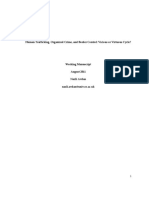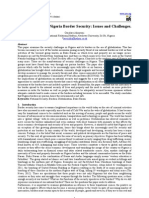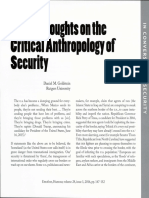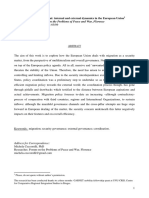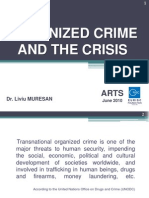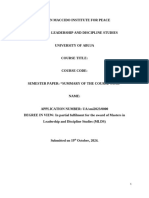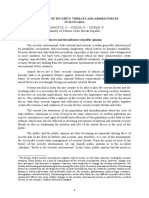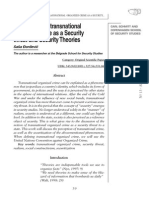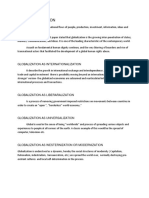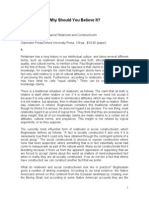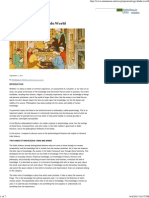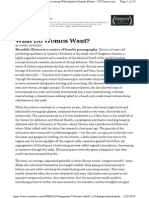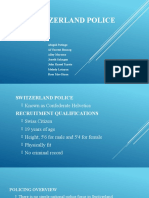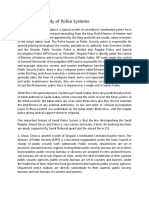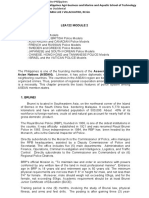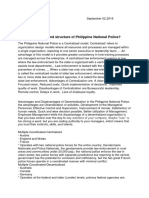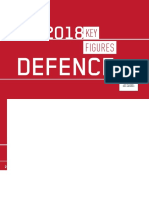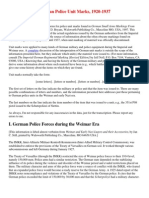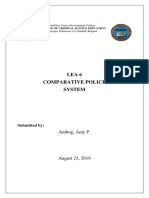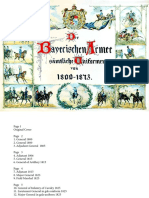Bigo When Two Become One Paris School
Bigo When Two Become One Paris School
Uploaded by
Iain CowieCopyright:
Available Formats
Bigo When Two Become One Paris School
Bigo When Two Become One Paris School
Uploaded by
Iain CowieOriginal Description:
Copyright
Available Formats
Share this document
Did you find this document useful?
Is this content inappropriate?
Copyright:
Available Formats
Bigo When Two Become One Paris School
Bigo When Two Become One Paris School
Uploaded by
Iain CowieCopyright:
Available Formats
When Two Become One: Internal and external securitisations in Europe
Didier Bigo
Threats, Internal Security and Defence: some entanglements
Society is undergoing fundamental transformations through the rise of new forms of governmentality in the Western world. The transnational is blurring the distinction between the internal and external, and destabilising related concepts: sovereignty, territoriality, security (Badie 1995). Sovereignty is meaningless and must be adjusted to the processes of European construction and economic globalization. The notion of borders is fading away and giving rise of the old notion of lines or fronts and regions, (NAFTA, Schengenland) and the concept of security must be adapted accordingly to take account of these changes. The transnationalisation of security opposes national (and societal) security. It creates, as in a Mbius ribbon, a situation where one never knows whether one is inside or outside (Bigo 1999, Walker 1993). This relation of inside and outside is central and more important than the need to distinguish between state and societal security (Waever et al. 1993). The process of securitisation is not only enlarging towards identity, it involves a more profound move. Internal and external security are merging and de-differentiating after a period of strong differentiation where the two worlds of policing and war had little in common (Bayley 1975). Now, especially after the end of bipolarity, external security agencies (the army, the secret service) are looking inside the borders in search of an enemy from outside. They analyse transversal threats (supposedly coming from immigrant, second generation of citizens of foreign origin, people from some inner cities or from the populous and disadvantaged suburbs). Internal security agencies (national police forces, police with military status, border guards, customs) are looking to find their internal enemies beyond the borders and speak of networks of crime (migrants, asylum seekers, diasporas, Islamic people who supposedly have links with crime, terrorism, drug trafficking, transnational organised crime). This so-called convergence towards new
320
threats and risks is considered the main justification for new structures and more cooperation between the agencies (internal as well as external) as well as a rationalizing of their budgets in a period of financial crisis for security affairs. The core of this new securitization is related to transnational flows and to the surveillance of boundaries (physical, social, and of identity), and can be seen as attempts to re-draw a border between an inside and an outside, a border different from the state frontiers.
Beyond the borders: policing today
Discussing the move of internal security agencies beyond their borders, numerous works have described the transformation affecting the national police forces of all Member States of the EU, even if we have fewer treatments concerning customs and police with military status (Anderson and Den Boer 1994; Anderson and Den Boer et al. 1996; Bayley 1985; Bigo 1992; Brogden 1990; Busch 1991; Fijnaut and Hermans 1991; Mawby 1990; Nayer et al. 1995; Reiner 1992; Van Outrive et al 1996). They have highlighted how the Europeanisation process interferes with purely national logics and invalidates analyses of internal security as an isolated phenomenon. The international is now both a constitutive and explicative dimension of internal security and police work, even if intellectual traditions and academic separation between internal and external tend to make one forget this. These works have shown that within the European area, national police forces from the different countries are driven toward closer collaboration and exchanges of knowledge. This is particularly the case for special police forces (against drug trafficking, organised crime, terrorism, hooliganism and illegal immigration). Information exchange (Interpol, Schengen Information System, Europol) has intensified, and new technologies (computers, telesurveillance) as well as new administrative personnel (liaison officers, officials from the Ministry of the Interior and the Ministry of Justice, security attachs within the embassies) have been set up in parallel with an exacerbated development of private activities in what has become an internal security market (Milipol). Poles of European groupings such as Schengen, Trevi - then the Third pillar of Maastricht, or Europol have emerged. In these areas of high policing, police work is not carried out simply at local or national level, but on a European or even international scale. This wider scope of internal security goes beyond the frontiers of the State and obliges a change in the notion of sovereignty (at the intellectual and constitutional
321
levels). Internal security will include undertaking activities such as surveillance of clandestine immigration, surveillance of cultural, religious and social influences from the country of origin of migrants and even on their offspring, surveillance and maintenance of order in so called problem districts, and control of transborder flows. The maintenance and restoration of order without opening fire, even in situations involving hostile foreign populations, are also connected to the first activities: they use almost identical knowledge, but in different contexts. Some French policemen or gendarmes explain that their knowledge gained in African riots or even in Sarajevo is relevant to the management of the riots in French suburbs. This crossing of the borders is not only territorial. The connection is also about identity: not the minority versus majority, but cross border activities and transboundary problems, including that of transgressing boundaries of identity with mixed marriage. Internal security thus implies collaboration with foreign countries and dissatisfaction with clear lines or borders between inside and outside, state and society, sovereignty and identity. Internal security activities block the possibility of distinguishing between an outside, state, sovereign security and an inside, societal, identity security. They are always entrenched and cannot be isolated from foreign policy or considered simply as the protection of national territory against internal threats by using national means. Internal security is not an internal problem between communities in a public sphere about the definition of national identity, internal security is a transversal vision of some knowledge about public order and surveillance inside or outside the territory, associated with specific devices of control.
Convergence towards the same enemy?
If internal security is not only from the inside, if it goes beyond the border, if it is transversal, is it because of the change in the nature of the threats? Is the inside adversary coming from outside? It could be an explanation and the transformation of violence in the last decades are an incentive for the de-differentiation of security, but it is not as a direct answer to violence that security is changing. It is through this connection between the devices of control and the management of fear and unease that links are made between military and police forces. The enlargement of the concept of internal security now links these two different universes. Military forces want to be in charge of the surveillance of the borders and to look for infiltrating enemies.
322
Although the street corner criminal and the soviet enemy used to belong to two separate worlds, the idea that police officers, customs officers, gendarmes, intelligence agencies and the army, all share the same enemies (terrorists and the countries that support them, organized crime and drugs trafficking, corruption and Mafiosi, the risk of urban riots of an ethnic nature and their implications for international politics with the immigration countries) is gaining more and more support inside different agencies. A common list of threats is being drawn up. A field of struggle and domination is emerging, as well as interests in cooperation. This field reacts on the socialisation of the agents and they act themselves as if a new situation constrains them to act now in a different way. So, security, and in particular internal security, must be understood as a process of securitisation/insecuritisation of the borders, of the identities and of the conception of orders. Securitisation is, in this sense, not an answer to insecuritisation, but a capacity to manage (and create) insecurity. When securitisation enlarges, so insecuritisation enlarges also, as metaphorically, it is the envelope of the sphere of security. More than that, sometimes security creates unwanted side effects towards other groups of people and as well as one having a security dilemma at the external and state level, one has a security dilemma at the internal and the community level. This dilemma creates insecuritisation due to self-fulfilling prophecy of security discourses, for example between migrants and border police, or between citizens of foreign origins and policemen controlling the suburbs. Internal (in)security must be analysed in connection with institutional knowledge and knowledge of the agencies, their devices and practices, including their discursive practices, as these are determinant factors in understanding how definitions of those who provoke fear, the adversary and the enemy are socially constructed. We need to understand the social construction of fears. And why they are now converging towards the figure of the migrant, as the key point inside a continuum of threats. In order to analyse the above phenomenon, it is possible to speak of a field of security where the different security agencies (police, gendarmeries, custom officers, army and information services, private security agencies and more marginally local security agencies, pro and anti-immigration agencies) participate de facto in the global redefinition of their respective attributions. This hypothesis of a security field where the border between internal and external security can hardly be detected (like on a Mbius ribbon), has the advantage of linking what is too often disconnected: namely defence
323
studies and studies on police. Such an approach enables one to understand that internal security extends beyond organisational questions of territorial defence on which the agencies focus. Consideration of internal security questions calls us to think about security issues in general, the relations between the State and individual as well as the relation to democracy in the contemporary age. They require us to retrace the structural evolutions and emergence of a risk society, which transforms the actual conception of security. They lead to questions beyond security needs, concerning not only the interests of social groups pushing for securitisation but also collective behaviour and cultural norms which form the framework of what we will call security and internal security in a given society. It needs to take into consideration who are the producers of the social construction of threats and how these fears are connected with (in)securitisation. So, even if we agree with some of the descriptions concerning the convergence of threats, they need to be analysed as a social construct which is not independent from the security agencies and whose legitimacy to declare the truth of the threats needs to be put in question. Such an analysis implies the articulation between a foucaldian approach and Pierre Bourdieus theory of field. The methodology which underpins this research is discussed in two other articles (Bigo forthcoming). Here I want only to illustrate what could be the transformation of this epistemological stance into specific research concerning the merging of the internal and external security. I want to explain why, at some points, the two dimensions of security become one.
The framing of the security question
It is difficult to find an article on societal security or about the enlargement of the scope of security which avoids a lengthy description of the transformation of threats, and which assesses that the governments reaction to these new dangers. Some demand global solutions and military involvements. Others refuse this militarisation of security and demand more police activities. Others want more prevention and less coercive measures to struggle against the threats. But they all agree that the threats come from the social world and that a government has the responsability to answer them. The notion of the survival of states, nations, collective identities continues to be at the core of these descriptions. But despite their claim to neutrality, these descriptions, are embedded with moral judgements, with prjugs concerning the legitimacy of fighting
324
against
crime,
the
Mafias,
the
terrorists,
or
the
Europeanisation,
the
cosmopolitanism.... They claim that, so long as they are well balanced between right and left, they have some truth. Have they? At the political level, for different governments, the legitimacy of reacting acts as a purification ritual where everything is legitimate against these new threats where exceptional measures are normal in front of such dangers. The lines between security and liberty blur. Liberty is not the limit of security but the condition of security, so security has no limits. Security is unlimited (Waever 1997). Security needs to be global. At that point, governments want to take account of all the different security agencies and to co-ordinate their activities without creating the problem of duplication of tasks which would disrupt their normal operation and raise the budget. Politicians at the national, European and sometimes western level want to say that they can answer these new threats. They ask for advice and many academics want to be councillors to the Prince. Notions circulate between political labellisation, administrative registrations and academic conceptualisations. Academics want to propose new definitions and new solutions for security, but often they begin with statistics coming from political labels or registrations of bureaucracies and they forget this point. So, they analyse security as a by-product of fears which come from society and which are legitimate even if they are without substances, because they are registered by state authorities. Discussions about the fear of crime or feelings of insecurity are good examples of this problem. Thus, a large number of academics are trying to help the government find an answer to a problem without recognising that they are framing some events as a political or security problem, and have part of the responsibility for how security problems become framed not of the events but of the aggregation of different events under the same category. Politicians and agencies uncertainty about where to draw the boundaries of security issues has had a marked influence on the way works on international relations were undertaken, if only as a result of the role of foundations and the financial structure of social science research programs. Some studies claim to be direct operational responses and flood institutions with contradictory recommendations explaining why NATO or the UN should or should not intervene to re-establish law and order, or why French or American soldiers should or should not intervene in urban riots. The available military and police means to combat the risk of migration are discussed without stopping a moment, just to think about the legitimacy of such a question. Other studies
325
avoid being so directly influenced by the interests of the different agencies and propose new concepts, but the knowledge stakes cannot be analysed independently from the power stakes. The redefining of security questions is not just a simple point of learning within the small world of internationalists. Disregard of this rule in the social game in favour of an idealistic epistemology sometimes leads international relations scholars to discuss the relationship between security, borders and identity as if they were pure concepts and as though their symbolic power were not drawn from the existence of institutions, which moreover are the same institutions that manage the governments claim to a monopoly on legitimate physical violence. The articulation of relations of knowledge, ranking and limits between concepts is thus also the articulation of the power struggle between the security agencies, a relation with the truth on what security means. To overcome the idealisation of security, the essentialisation of a meaning of security, one of the best approaches seems to be to analyse security as a device, as a technique of government - to use a foucaldian framework. But security does not emerge from everywhere, it is connected with special agents, with professionals (military agencies, secret services, customs, police forces). And it is only if we follow in detail how they manage to control people, to put them under surveillance, that we will understand how they frame security discourses. If we refuse to do this sociological work, if we try only to analyse the inter-discursive practices (which has the advantage of leaving the researcher alone, far from these bad guys), we will intellectualise the securitisation in a way that is correlated with the habitus of the researcher which does not fit with the habitus and practices of the security agencies. To analyse these processes fully requires spending time with the people of the agencies, understanding how and why they use these techniques, and their legitimation of the routines of coercion, control and surveillance.
Analysing securisation/insecurisation practices
Too often, analyses of security are far too inattentive to the social practices of security professionals. In many cases they are the product of secondary rationalisations which reduce security or identity to natural objects. These are discussed as if they were things. There is an attempt to define security or identity by reifying their objectifications as natural objects. As Paul Veyne puts it:
326
We are taking the spot that a projectile is going to land of its own accord as an intentionally aimed target. We apply a philosophy of the object as end or cause rather than a philosophy of relation which approaches the problem not from both ends, but from the middle, from practice or discourse. (Veyne 1971:97)
The evolution of security and its various forms throughout history is explained either as an anthropological need (ontological security or security desire), as a legitimate demand from citizens (safety), or as a speech act which varies according to the moment (security discourses), rather than analysing the practices of securisation/insecurisation and the set up of the social power balance that enables them to be applied. This neglect of practices, of the actions of security agents, is a result of an inversion that would have us believe that what is done determines the doing, when in fact the opposite is true.
The illusion of a natural object (the governed throughout history [or societal security]) conceals the heterogeneous nature of practices. The governed are neither one nor a multiple, any more than repression is, for the simple reason that it does not exist: there are just multiple objectifications which are correlative to heterogeneous practices. The relationship of this multiplicity of practices to a unit only becomes an issue if one tries to ascribe a unity that they do not have ; a gold watch, lemon zest and a racoon are also a multiplicity and do not seem to suffer from the fact that they do not have either origin, object or principle in common. Only the illusion of a natural object creates a vague impression of unity...there is no subconscious, no repression.. just the eternal teleological illusion and we are wrong to imagine that the doing, or practice, can be explained based on what is done, as on the contrary, what is done is explained by what the doing was at any point in history. Things, objects, are simply the correlate of practices. (ibid.: 99)
Thus we should not reflect on the right definition of security and the diverse forms that it takes according to the sectors, but on the securisation/insecurisation practices which run through the internal sphere as much as the external sphere. We need to analyse the
327
heterogeneity of practices and we should remember that practices are interspersed with empty spaces, that they are few and far between and that objectifications fill the space by updating the potential left in the hollow. If the neighbouring practices change, if the limits move, then practice will update the new potentials and it will no longer be the same. A genealogy of practices is necessary. And we need to ask in each case: what exactly are the practices of coercion, of protection, of pacification, of fixed guard, of control, of surveillance, of information gathering and sorting, of information management, of covering areas, of calming, of dissuasion, of locking up, of turning back, of removal from the territory, all techniques which are used by security agents, and through what technology? Each has its own repertoire of actions, its own knowledge, its own technology. Practices are heterogeneous and dispersed, but are they not the response to political rationality? And if so, how should we envisage that rationality? As Franois Ewald points out, either it is examined from the point of view
of the practices that it orders or forbids, of the way in which it problematises its objects, and it is a programmatic rationality, or it is examined as a diagram rationality by looking at the practices and trying to identify what the plan for their set up, what the ideal of their adapted function, may have been. (1996: 17)
This diagram rationality crosses the whole of society and can be found in the most basic representation of immigrants. Nevertheless, it originates in the practices of security professionals and we can certainly evoke the field that these security professionals constitute, one of whose aims it is to manage and control life through concrete organizations such as schools, hospitals, the police and the army.
Delimiting the problem of internal security - the perspective of security agencies
Security on an internal level: from police to internal security Security is no longer an issue which can be solely assimilated with the collective security of a state, it also, and increasingly so, concerns the individual security of each
328
one of us - whether the individual is threatened by criminal acts or from attacks from abroad. The contemporary state is no longer only held responsible for assuring the institutional survival of the collectivity, it must also guarantee the personal survival of each of its constitutive members, regardless of where they are. An attack which occurs thousands of kilometres away from the national territory, but which involves French citizens will be considered as an unacceptable threat to security. Its the same concern that is expressed when as stating that too many people voluntarily use drugs and endanger their lives. Similarly, concern is expressed with regard to religious conversions (Islam, for fear of radical proselytism; sects for health reasons). The semisettled foreigner, even when he has citizenship, is suspected of disrespecting the host societys norms and of disturbing the notion of public space. The State thus wants to take charge of individual security and widen the notion of public order. It aims to realise the truth programme, that it has been trying to assert for a long time with contract theories, but lacked the means to carry out. Control and surveillance technologies and new knowledge in the social sciences reinforce this push towards maximising security, to implement a body politics, to have a life policy where the production of life is more important for the government than the right to deliver death. At the same time, the practical realisation of such a truth programme involves an ever increasing delegation of responsibilities to the private commercial sphere. This gives rise to important contradictions. The illusion of mastering life disappears under the pressure of commercial and capitalist approaches. Class logic is resurfacing and the private sector tends to objectify security through selling goods and advice about the good and secure life. So, the state has perhaps less impact than ever about the social practices of securitisation even if those responsible say the contrary. They are more and more interdependent with social and commercial interactions. They cannot escape this privatisation of security issues and they cannot continue to distinguish between state and non-state security. This change in attitude of the state, the will to master individual security, must not of course be exaggerated. It has been a slow metamorphosis during which the citizens points of view have been gradually taken into consideration. It is the progress of democratization and state making that has taken place over centuries (Bayley 1975; Elias 1993; Lacroix 1985). We will not develop here - as it is not the aim of the paperhow the state progressively affirmed its claim to assuring and gained an effective monopoly over crime control in its territory, nor will we expose how this latter function
329
has been increasingly contested as the state has acquired the means to control the coming and goings over its borders, the movement of people within its territory, and delinquent populations (Foucault 1975; Reiner 1992; Tilly 1990). Possible illegalities have indeed been reduced through the multiplication of laws, legislative and administrative networking, control technologies (identity cards, passports) (Noiriel 1991; Torpey 1996) and although they have always been taken care of, it has not been without provoking near revolts and, in each instance, installing great fear in the leaders (vagabonds, anarchists, working class as dangerous class, lumpenproletariat, longhaired youths, and now youths from the ghettos) (Cesari 1997; Delumeau 1989; Duhamel 1993; Rey 1996). By reinforcing surveillance over a specific group, the state has been able to consolidate its hold over territory and guarantee the security of other strata of the population, but at the same moment securisation has created insecurisation, fears and the myth that the full implementation of the public order, of tranquillity, of the peace of the public space is always endangered by revolts, or even by hunger strikes of the people excluded or under surveillance. So, as Norbert Elias has pointed out, the pacification of customs and the reduction in murderous crime over a long period, in parallel with the strengthening of both selfconstraint and state power have not diminished the feeling of insecurity. The immense fear of losing ones life and soul (in the course of ones travels) while travelling the highways and byways has instead been replaced by the multiplication of trivial fears concerning ones property (Elias 1993). The population could all the more easily change their concerns with regard to security because the essential was no longer endangered. It is only in times of social peace that we feel threatened by uncivil actions of our neighbours (Roch 1993). The feeling of insecurity experienced by the individual is always relative to and conditioned by a particular context of global security.
The role of the police and the discourse on their role has evolved and become more complex. The massive transformations of the construction of the parliamentary State and its legitimation have been followed by the progressive demilitarisation of the police. The state police also wanted to be societys police. Intelligence is but one of the tasks of the police, whose functions also include providing emergency aid, crime control, assuring public order i.e. peace. The police organisation brings together very diverse professions and duties (Berliere 1991; Buisson 1949; Buttner 1987). With the development of a parliamentary system, the state learned to look after its populations
330
and no longer to treat them as enemies, even during uprisings (, Rabinow 1991; Veyne 1971). The individuals security has become an increasingly important issue and the populations expectations in this area have been reinforced to the present point where public organisations fall far short of being able to satisfy the massive demands for security. The privatisation of security was created by the will of the state to implement its own program. The focus on identity, on personal security, falls into the private sector. Politicians try to disengage themselves from individual security but too many links were created between public administrations and private agencies (recruitment, money, personal links with politicians). This short genealogy enables us to reposition what is at stake in internal security (cahiers de la scurit intrieure no. 3 and 24). For centuries crime has been treated in an ordinary way without major implications for politicians. Even if the latter were aware of threats of revolutionary subversion, they were not concerned with individual security. Now, however, police issues have become political issues in the sense that they incite public debate (Edelman 1964). If one were to exaggerate somewhat one could say that whereas before police only had to do their work and the state had only to provide them with the means for doing so, now governers are asked for explanations: explanations concerning both crime and police (Robert and Sack 1985). With regard to this change James Rosenau (1990) speaks of a transformation in the allegiance system and an obligation on the part of the state to get results in security matters whereas before the state was obeyed and no one questioned its competence. The widening of internal security is due to the fact that the security of individuals, their personal feeling of insecurity and the link between this type of security and collective security has progressively been taken into account via security of citizens and society and no longer via the state and national security. This heavy structural tendency towards management of individual security and taking care of the individual by way of all conduits of the state: societal security, civilian security, road security is part of the development that Franois Ewald has termed an insurance society (socit assurantielle) where risks are minimised. Numerous liberal thinkers have quite wrongly viewed this phenomenon as a suffocation of individuals by the state. On the contrary, individualisation only becomes possible when a state exerts its control in this domain. The two phenomena - individualisation and state control - are in fact two different side of the same process. For a long time individual security was considered in terms of a given territory delimited by state borders. This was the scope of the states responsibility. Beyond
331
national boundaries, one could only rely on other states (Chapus 1997). Now the security of nationals abroad has become a constant concern for western nations. Numerous military operations have been carried out in the name of such a priority, even if this were to conceal other priorities. One evoked a secret return to a canon policy, or inversely the humanitarian dimension alone was stressed, or otherwise one spoke of an appeal for imperial intervention (Rufin 1996; Salame 1996). However, it seems that what was at stake in all cases was above all a transplantation of internal security operations to foreign territory (Cultures et Conflits 1993:11). The techniques used in these operations transformed them into international police operations for maintenance of order, and not armed conflicts. The mobilisable knowledge in conjunction with this vision of things was often poorly understood by public opinion and the media. International mobility, movement of populations, especially tourists, has rendered ones relationship with the territory more complex. The notion of citizenship has supplanted a purely territorial logic. Security can no longer be conceived as protection behind state borders: borders that they have tried to make as impermeable as possible. Although numerous texts uphold this vision of a fortified castle or a fortress nation or Europe, it is undeniable that the security of individuals has become deterritorialised. It now depends on networks, agreements between countries and security agencies and private insurance mechanisms. (Bigo 1996a). What are the present consequences of such social global transformations? The notions of internal security, individual security and the security of citizens have become politically important issues, surpassing in this respect police and crime issues. There has been a tendency towards assimilating the police with the public service, despite resistance from those with monarchic views. Police issues have been politicised by placing them under the banner of internal security in the sense that what was before a little police matter is becoming an important stake in political struggles, especially as it seems to be a decisive factor in determining undecided votes, particularly at the local level. The politicisation of internal security issues has gone through cycles of secrecy and public exposure. There is nothing radically new about that. But, what concerns us, one could say that it was in the 1980s and 1990s that questions about police become the subject of public debate, at the same time as discourses on urban insecurity and the city on the one hand, and discourses about stopping immigration of salaried manual workers, on the other, appeared (Ackerman et al.1983).
332
It is in fact possible to consider that the real turning point was when questions about urban insecurity became important (in the mid 70's, first in the USA and Canada, then in Great Britain and Germany and after in the beginning of the 80s in Italy and France). At that time, these questions were approached from the angles of destructuration of citizen identity, anomie, loss of values, and geographical and social exclusion. Confidence in the city and civilisation had been lost. A declinist discourse had emerged. In connection with the latter there was a progressive transition between discourses on the working class (a loss of meaning in the workers movement, a loss of coherence), the role of immigrants (different values and religions) and a discourse on problem districts (inner cities or suburbs) as well as delinquency (the informal drug economy). The existence of extremist parties with anti-immigration rhetoric and their relative electoral success in certain countries reinforced the belief that public opinion was largely security orientated and sensitive to arguments for a greater use of coercion. Politicians were quick to ethnicise the urban problem and numerous discourses revolved around the merits and drawbacks of multiculturalism. The mid 1980s saw the increase in political violence by clandestine organisations on European soil. This, in conjunction with the Iranian Revolution and the Middle East situation, served to reinforce this climate of anxiety and turn the focus not towards all immigrants, but on those coming from Islamic countries swept up in the wave of re-Islamisation, or countries in the middle of civil war. Islam, especially when it reached the Maghreb, was seen as a direct threat not only for these countries but for Europe too, and particularly for France. A durable connection had been made. There is no doubt that politicians fears concerning political violence of Islamic radicalism, discourses on urban insecurity and the transformation of migration flows, play a decisive role in the progressive politicisation of crime, insecurity and immigration. Internal security emerged at the time when economic and social questions started being approached from a security and cultural angle and when this latter perspective became important in determining institutional replies to these questions. There emerges a dialectical tension between internal security and national territory: as the latter appears to define the scope of so called internal security, the security agencies themselves are more concerned with what is going on beyond the national territory. They are more interested in security beyond the border than in focusing on identity inside the border, on multiculturalism problems. Local and practical problems are now under privatisation and they move from that to transversal security. Politisation
333
and public debate, consideration of individuals feelings of insecurity, the connection between territorial protection and border crossing, the necessary collaboration with foreign countries: put together all these points form a polyhedron through which internal security is rendered intelligible (polydre dintelligibilit, quoted by Foucault in Dits et Ecrits (1994:vol.II). Internal security thus implies, inconsistent with the traditional activities of the national police, a widening of the geographical sphere of activities. In other articles and books lengthy descriptions have been given as to why the establishment of a common enemy enabled the idea of police collaboration, how the CIPC and then Interpol developed, and why it was that Europe, first on an informal basis in the 1970s and then formally in the 1980s, was chosen as the platform for negotiation between police of the EU countries. It is crucial to understand that internal security cannot be reduced to the national territory. As it has been shown in both debates and actual practice (including the formulation of legislative norms), internal security has developed on a European scale. The number of countries participating in these forums has increased - the Nordic countries including Norway and Iceland have joined and the central and eastern European countries and even Russia are interested; USA and Canada have a role in these forums as does Switzerland - to the point of diluting the notion of Europe. Judicial norms have been constituted (Articles K1-K9 of the Maastricht treaty, recommendations from JAI Council, Conventions including Europol, the Amsterdam treaty which places further constraints on national governments, the Schengen requirements). The sphere of security activities has extended to include migration flows and transfrontier flows. Europeanisation had the effect of allowing a logic of confidentiality to come to the forefront. It meant that administrations and experts from each country had to confront each other, but it also allowed them to avoid dialogues with other sectors in their own society. Not only were associations excluded from the game, but so were local actors and parliamentarians. Even local police were progressively marginalised and replaced by European specialists. The technicality of the matter served to justify their absence from the debate. Paradoxically, Europeanisation thus served to reinforce the tendency towards secrecy and confidential reports. This was all the more so because the procedures that were chosen excluded the Commission from playing its role. There are endless examples. All these phenomena prove that internal security is a way of labelling the transformation of professional practices and not simply an ideological discourse.
334
I have shown elsewhere (Bigo 1996a) that police forces are not to simply responding to the developments in crime; as crime is now organized at European or international level, it is not a kind of functional spill over that has now reached police functions. We have analysed the semi-autonomy of the security agencies by highlighting the transformations within the world of security without regarding these transformations as a pure reflection of and reaction to the evolution in violence and crime. We have shown that it would be inconsistent not to analyse these developments in violence, but that the main point lies in the way that the social structure of the threat induces the police not only to rise to these threats but also to take part in their definition. These games of defining what is and what is not threatening can mostly be explained away by inter-agency rivalry and by the politicization of matters of public security. Thus, to sum up, it could be said that internal security has experienced a double widening process. It extends beyond the national territory and is directly linked to European and international issues. In no instance is it autonomous and independent from the collaboration of security agencies (police, customs, gendarmerie) on an international scale. On the contrary, its existence is almost wholly dependent upon such collaboration. This widening of the network of contacts which the agencies judge as necessary to combat terrorism, drug trafficking and organised crime raises the questions of levels of trust and confidentiality as well as that of the autonomy of an internal security (and immigration) policy of each EU state with respect to the whole of Europe. We will return to this later. Internal security is also connected with the emergence or not of a feeling of European citizenship which overflows national frontiers, and reactions from different social groups with respect to practical consequences of European citizenship on national life. If internal security extends beyond the national territory, we have insisted that it also extends beyond the usual activities of the police and gendarmerie. The connections which are made between terrorism, drugs, crime, delinquency, border surveillance, fighting against major drug trafficking, and controlling clandestine immigration widen the spectrum of public security towards different activities: information and military activities to fight against clandestine organisations coming from abroad (from a government, community or diaspora) who use political violence against citizens or use the national territory as a transit site or for sale of drugs, and have an effect on the usual activities of custom officers (border controls, the fight against drug trafficking, economic intelligence) who find themselves drawn into internal security, surveillance activities which are increasingly delegated to
335
private operators on a local scale. The connection is stronger when the different agencies use the same technologies and knowledge (fingerprints, unforgeable ID, computerised tracking of entrance, residence, accommodation and exit, setting up expert IT systems, satellite surveillance, widespread data-stocking). Policing is now carried out using networks: networks of administrative bodies in which customs officers, immigration offices, consulates and even private transport companies and private security companies join forces with the national police forces and gendarmes; networks of information technology with the creation of national or European data files on wanted or missing persons, on those who have been denied residence, expelled, turned back at the frontier or refused asylum (FNE file on foreigners, FPR file on wanted persons, OFPRA -files on refugees, SIS Schengen file, Interpol and Europol files); networks of liaison officers that have been sent abroad to represent their governments and enable information exchange; networks of semantics in which new doctrines and new concepts on conflict and political violence are developed. Remote policing is ever more frequent with work outside the national territory and the help of technology. Security checks are no longer necessarily done at the border on a systematic and egalitarian basis, but can be carried out further downstream, within the territory, within the border zone or even upstream with police collaboration in the home country of the immigrants, through visa-granting systems and through readmission agreements. There is a change in the categories of police action (from national police forces controlling national crime to internal European security, tracking world-wide organized crime, migration flows and refugee movements), a change in security-check targets (from the control of and hunt for individual criminals to the policing of foreigners or to the surveillance of so-called risk groups that have been defined using criminology and statistics that, according to circumstances, bring them to focus on extra-community immigration and those diaspora that are the origin of the most frequent and most serious of threats to security), an alteration in the time frame of security-checks (from systematic, generally slow intermittent checks to virtually permanent surveillance that focuses on a few target groups and reacts with maximum rapidity). Thus systematic control of the territory has been marginalised, although it still exists, in comparison to the surveillance of certain populations. New practices are emerging. New posts such as liaison officers and police attachs in embassies are being created. A result of these new forms of control is that face to face relations are decreasing in favour of a proactive mentality where one tries to determine which populations are likely to commit an
336
infraction before they even do so. These methods are applied to crime as much as to immigration. Target categories are identified through the statistical analysis of information produced by the networks, and they become the object of increased surveillance. The idea is to anticipate the flows and movements of particular groups rather than to follow individuals after the fact. This is done by morphing, where a scenario is reconstructed from just a few fragments. The very term policing loses its sense when it is widened outside crime control to such an extent (Bigo 1996a). Indeed, the term internal security takes into account this extension of police activities to cover a wide variety of fears and insecurities. This widening of internal security leads to its interpenetration with external security which is itself undergoing complete change and restructuring due to the questioning of realists and neo-realists theses on security (associated with Defence) and the emergence of a transnational view of security. It is becoming difficult to differentiate between internal and external security and divide them into distinct sectors. The Vigipirate plan against terrorism in France is one example of the ambiguous relationship between Ministries of internal and external affairs. They are both in fact merging so as to end up constituting the one and same security field.
Security in the external arena: from defence to internal security The military no longer know what their duties are. Honour and sacrifice associated with death in combat are exaggerated by some who fear that these values will become folklore and are condemned to disappear. The socialisation of the soldiers profession and learning about the licence to kill have been replaced by a muscled maintenance of peace. The rules of engaging in combat have been modified. In certain extreme conditions, soldiers in their role of surveillance become targets for the enemy (blue and white helmets) and do not have the authorisation to engage in fire. This provokes much questioning which is only partially masked by political obedience and discipline. So far, studies on humanitarian interventions have been more focused on motivations and legitimacy than on the practical knowledge that is mobilised. Should one send the military or the gendarmerie to carry out these operations? What should be thought of the establishment of Civil Affairs to accompany certain so-called humanitarian peacerestoring operations? What should the military be used for? As politicians see it, war is indeed an external projection but this justification alone calls upon the global legitimacy of the army. The military are returning to the national
337
territory and emphasising the role of protection. The military are thus returning to the interior at a time when war beyond national borders has become a rare occurrence. If war and the state, war making and state making, have been closely linked in the history of European state formation, if the army has defended the collective security of the group from aggression by other groups or communities, enabling the distinction to be drawn between combatants and non-combatants, the front and behind the front, if behaviour was for a long time determined by the protecting function of borders, now we question the role of war and predict the end of the military order. If all threats stemmed from the Soviet enemy, did its disappearance mean that we were then moving towards global peace and the end of conflicts? If this was the case, another painful question arose: what should be done with the military, with defence industries? What was to become of defence after the Soviet enemy had disappeared? Without taking the same view of numerous NGOs that were demanding peace dividends, governments took advantage of this wave of ideas to cut spending during a period of economic and financial crisis. Entire sectors of activity are being questioned. Arms and research programs are being cancelled. In some countries the format of the army is being altered. In France it is being made professional, despite the long tradition of a citizens army. Defence industries have been caught unprepared and in certain countries reconversion programs using high technology for border surveillance and immigration control have been developed. An additional link has been woven between internal and external security. Economic and financial interests have emerged inciting translation of the spectrum of threats and the rediscovery of local conflicts and their socalled damaging effects. By the mid 1990s a sort of global configuration of convergent representations had emerged which joined internal and external security, integrating the former into the latter. Crime, borders, immigration, threat to national identity and the ideology of the Fifth Column became inextricably intermingled and were taken up again in a matrix which owes practically everything to defence research in which the habits of the actors had been formed. The potential power of terrorist activities and their effectiveness against democracies have largely been overestimated, as this enable a link to be made between exotic conflicts and national territory. In the same step a link has been established between terrorism, drugs, organised crime and immigration through the terms grey zone and urban savages. The recent debates on the threat from the South and the clash of civilisations have shown exactly how these shifts in positions have come
338
about and why, trapped as they are between the hammer of the benefits of peace and the anvil of the threat from the South, those who never really believed in this threat but have budgets and interests to defend have adopted a standpoint in which terrorists and Mafia groups are their new enemies. The end of military rule referred to by Maurice Bertrand (1996) implies reconversions that are not simply of equipment. The strategisation of the threats to internal security is self-justifying. This strategisation has some practical consequences. It more or less redefines the tasks allotted to the different services. The Italian Minister for Defence points to Islamism as the threat that replaces the threat of communism and proposes the use of the army in immigration control. In Germany, Helmut Kohl considers the PKK an exclusively terrorist party and a threat to national security. In France, the bomb attacks of 1995 relaunched the surveillance of all immigrant associations and the strengthening of legislation concerning not only terrorism but immigration and political asylum. Apart from Islamism considered as subversive terrorism, all countries talk of a grey zone, of global Mafia organisations and of changing forms of criminality (Raufer 1993). Intelligence services turned towards counter-espionage have found new missions with the infiltration of Mafia networks and economic intelligence but still use the same procedures. On the other hand, the vision in terms of an external projection of humanitarian operations has concealed the meaning of missions carried out and cleared questions of projection from internal security, whereas they should undoubtedly be linked. Thus an important link between internal and external security has been neglected, because it functioned in the other direction and brought military activities closer to police activities. Thus far from being an extension as some rhetorics argue, external security is in full retraction or at least, redeployment. In certain countries, the army format has been transformed. Everywhere budgets are cut. This situation is very different from ten years ago. This change in such a short time frame has destabilised the most deep-set beliefs. As war has been replaced by international police operations, operation for restoring peace, which mobilises a different knowledge, the military find themselves in situations of international collaboration where they have to take care of restoring peace, in the same way as police and gendarmes. Consequently, they transfer internal security beyond the national borders. Should one then consider sending police and gendarmes instead of the military? Such chass-croiss (mix-ups) whereby the military would operate internally and the police externally are destabilising.
339
As in the case of the police, internal security appears here a priori as a means of labelling practical transformations within the profession. Indeed, it is a more delicate matter when demonstrating this same transformation with the military. Studies need to be done on the Europeanisation of defence forces and the networks that have been constituted by the WEU and Eurocorps, both within and outside the NATO framework. Nevertheless, the same thing is at stake: internal security does not mark out the same universe of practices, as territorial security, it marks out what is in the process of changing within police, gendarme, customs and military activities.
Internal security and the intermediate agencies: from marginal to central roles? The uncertainty surrounding the missions and limits between the social universes of the police and the military affects in particular the organisations and agencies, such as the gendarmerie, or a number of border police, which find themselves positioned in the interface between these two social universes. It is these bodies at the interface which consider this uncertainty an attack on their professional identity, and which are anxious about their future (customs, certain information services), or who on the contrary, such as the police with a military status (gendarmerie, bundesgrenzschutz, carabinieri, guarda civil), consider these transformations of violence as an opportunity to occupy a recognised position amongst the agencies specialised in safeguarding public order and those specialising in combat and dissuasion. These agencies are thus the first ones to insist on the interpenetration of the internal and the external, on the transversal dimensions of the new threats, and on their specific knowledge. They do not see themselves as marginal to these two worlds, as devalorised intermediaries in the two social universes, but as central in the face of one and the same universe in constitution. This is so to the extent that a large spectrum of their activities allows them to be present where the police dare not go (restoration of order in a crisis situation), and where the military do not want to, or do not know how to intervene (not to kill the enemy, but to control the opponent). Thus the French gendarmerie considers that it has been prepared for centuries for these missions of internal security, pretending that it possesses an advantage over all other corps due to its role as soldiers of the law, to its power to use military means which it masters in a civilian context, while knowing not to transform its opponent into an enemy to be eradicated. The gendarmerie favours, they say, the unbroken passage from the normal period to the crisis period, or even war. Well adapted
340
to low intensity conflicts, whose extent exceeds the regular bounds of national police actions, but which do not justify the intervention of other armed forces, it is essential. It is able to respond better than other institutions to the continuum of peace, crisis, and war and can deal with prolonged crisis. Its structure, being of variable geometry, allows it to closely accompany the rise of violence without a brutal change of position and without breaching the public opinion threshold. Moreover, what it has learnt on French terrain, it will be able to apply at the other end of the world, or so it is believed. The transfers of knowledge between the interior and the exterior, the intimate knowledge of crisis management, could be important assets. Exploiting the fact that it is both civilian due to its missions, but military due to its statutes and missions in times of crisis, the gendarmerie considers itself ready to be the kingpin of internal security missions, missions in France or abroad. The customs agencies, in their reorganization, tend also to modify their design of security. Previously focusing on considerations of public health, of hygiene, of transport, there was little place for questions of the drug traffickers or infiltrations of organised crime. The border was for them the place to work on. Now they think in term of zone, infiltration of networks of traffickers, information by collaboration with their foreign colleagues. They paradoxically are more influenced by the American methods of the DEA in the USA. For these agencies the concept of internal security cannot be reducible to the security of a closed territory protected by insuperable borders. This concept of interior security is rarely used. They are the first to favour an analysis in term of transborder networks, of securisation of the human networks, of monitoring of flows. Security at the borders is necessarily transborder and is ensured by international collaboration of the security agencies. Their vision of security seems the most influenced by the transnational approach and this is undoubtedly because they listen more than other agencies to their economic partners. They also differentiate explicitly between threat and risk. Unfortunately these agencies are one of the least studied as security agents. There are many other examples of the de-differentiation between matters of internal and external security. For example, the intelligence and counter-espionage services (MI5, DGSE, CIA) have only about one third of their staff working on espionage, and as the rest focus on international terrorism, economic intelligence and issues such as the laundering of drugs money. Thus they enter into competition with the drugs squads of Europol and Interpol. On the other hand, Europol wants to deal with nuclear crime and
341
follows the transfer of fissile material from one country to another, but in so doing it is poaching on counter-espionages and the armys hunting ground of nuclear proliferation. The German border police (BGS) has undergone reforms that nearly doubled their number and altered their mission, thus provoking intense debate over the nature of their military status, particularly when they were invited to take part in missions outside the NATO area. Thus if one wants to summarise the positions taken by the different agencies, one can distinguish two different visions of internal security in relation to their structural positions inside the field of security. The first type of discourse is based on the traditional concepts of territory, national sovereignty and objective threats to collective security. In France this is the positions of the army (terrestrial as well as aerial headquarters) and of the urban police. It assumes there to be a difference in nature between internal and external security, the activities of police forces and military activities. In this traditional view of security, coordination is necessarily minimal: it is limited to periods of crisis when national territory is attacked by foreign forces. Otherwise, interior security falls within the competence of the police forces and it is dangerous for soldiers to intervene as this would be to risk drifting towards the national security doctrine. This vision is structured around the concepts of physical borders of the state, territorial security and military defence. The aim of security is protection from threats, it is an established fact. The second conception which is more the vision of the gendarmerie nationale, the customs, and the UCLAT (the anti-terrorist squad of the police) is founded upon a transnational approach to security. In this view, internal security always has an extraterritorial dimension and the opposition between internal and external security is a pretence. There is, indeed, dedifferentiation between the internal and external. What occurs in one affects the other and vice versa. The same analytical frameworks and same repertoires of activities can be applied to both. Cultural norms relativise the separation between an internal policed order and an anarchic international order: missions of maintenance of law and order, both internal and external, take the life of the individuals into consideration and war tends to become a disqualified mode of action. The agencies which have the knowledge to prepare for violence without entering into war are privileged. Furthermore, internal security has a geographical dimension which extends beyond national borders. It is European, Western, or international in the sense that it is based on networks of collaboration between security agencies. Whereas before
342
there was a clear and simple division between administrations based on border demarcations, there now reigns a complex overlapping of activities. Whereas before it was possible to clearly distinguish between the police and the army activities, now a field of the security has emerged whose central knowledge is located at the interface between the police and military. The interest in studying the vision of the agencies of internal security lies precisely in the fact that it cannot be reduced to traditional questions of security in the way they are treated by realists and neo-realists. Internal security is not the opposite of external security. Instead, internal security questions destabilise the border between the internal and external, as well as between the state and the individual. It is indeed from here that both their complexity and their interest stem.
Internal security and societal security as seen by the international relations theorists
Internal and societal security All these transformations force us to reconsider, not only internal security, but the concept of security itself, its link with the notion of defence, and the role which armies can play with regard to overall or sectoral security (military, civil, economic, environmental, internal or societal). This brings us back to the debate between analysts and their influence on politicians and security agencies (Bigo 1996a). Even in the 1980s, the immense majority of IR scholars and strategists did not consider internal security to constitute a legitimate part of security studies. For them, the latter was related to the agenda of Defence policies. In the Anglo-American debate defence and external security were considered as synonymous. Defence always referred back to the military component alone, and security was assimilated with the collective security of the nation. To speak about security seriously was to envisage developments of defence systems and policies. True security was that which concerned the physical survival of the nation, and its protection from potential armed aggression (Walt 1991). Beyond this acceptance of security as existential survival, security lost its purpose. Security was a strategic affair of the state. Resistance to any intrusion in this field, or attempts to draw parallels between civil and military security was savage. It was claimed that the values of sacrifice to the safety of the nation made all the difference
343
and that it was scandalous to compare the missions requested from the army for civil security and its proper military missions. French people, very often generals, in some rare exceptions, tried to put forward their originality insisting that in the design of French defence (the organic law of 1959), it was impossible to reduce military affairs to defence; that defence was global and included military, civil and economic components. But they were too little involved in this debate. Thus, it was necessary to wait for the pioneering work of Barry Buzan to rediscover these questions. Buzan in his first edition of People, State and Fear (1993), lets us know of his irritation at being confined in strategic studies, discussing SDI, technology, disarmament, without any thought about the concepts. He noted the shift between the concerns of the analysts of defence and security and that of politicians asking always for more studies on terrorism, drugs, immigration. Thus, he proposed to study the specific logics of security. According to him, security went well beyond defence and affected the sectors of environment, the economy, politics and society (Buzan 1991). He noted a broadening of the spectrum of security to new objects, and to new sectors. By delinking studies of security from studies of defence, he re-established a real theoretical dimension to the question of security. First, he insisted on the fact that, contrary to the realist approach, it is impossible to reduce security to national security. Nevertheless Buzan did not cut all the bridges with the traditional vision of security. While proposing to define security in terms of survival or as freedom from threats, he continues to declare himself a structural realist. From these theories he picks up the idea that security is a fundamental human need for individuals as well as for communities, and at the level of the states, security was analysed as the absence of threat against the survival of the nation. One could thus, according to him, possess a certain dose of security, one can analyse objectively the probabilities that security is threatened and react consequently (new system of weapons, reinforcement of alliances). Within this conception, even if the purpose of security affects varied sectors, one can continue to distinguish each sector clearly: the strategic stakes remain independent of the ecological or societal stakes. There is no confusion or superposition or merging between the various sectors and each one has its own logic. As Jef Huysmans noted, it seems that each author preferred to add an adjective to characterize security (global, economic, environmental, etc.) without taking the trouble to define the object of security, other than by its opposite: the threat, and without explaining this latter concept (Huysmans 1996b).
344
Thus the real innovation came later, in 1990 and in 1991 when, in their common works, Buzan and Ole Waever proposed aggregating these five sectors in two categories: national security, having sovereignty and the survival of the regime as its main concern; and societal security having the identity and the survival of society as its main preoccupation. The distinction between threats to sovereignty and threats to identity was their main contribution to research on the subject. The concept of societal security had been born and was designed to release security matters from the narrow sector of military defence. It was typically American, forged by the distinction created by the Posse Comitatus that internal and external matters were clearly separated. It was very different from the French, but also Spanish, Greek visions that defence includes civil matters. In those countries constitutions create a hierarchy (in the sense of Louis Dumonts inclusion of the contrary) between defence (as a whole), including defence (as military matters) and civil affairs (as coordination between civil and military peoples). But who cares about exotic countries? Nevertheless, the semantic innovation of societal security had a real success. The term of societal security was immediately adopted by other IR scholars as well as by American officials in charge of State Department (even if they mainly use the term internal security and not societal security in their administrative documents). The category of societal security was more or less used to discuss the so-called new threats coming from society itself and migrants. It was used as a semantic equivalent of internal security or non-military threats. This ambiguity was also present in the first book by Waever and Buzan et al. (1993). According to them, societal insecurity is on the increase with the end of bipolarity, it is Society more than the state which is threatened, they claim. The perception of a threat to identity comes, on the one hand, from cosmopolitanism, from a standardisation, and, on the other hand, from the flow of immigrants and from ethnic fragmentations. By way of supporting their claims, they refer to the rejection of Maastricht by Denmark, the xenophobic attacks against asylum seekers in Germany, and the policy of ethnic purification in Yugoslavia (Waever et al. 1993). According to them, the notion of security must therefore be enlarged since from a moral point of view in order to find a solution to the problem, one has to feel concerned by all threats whether they are aimed at the state or at society.
345
These sentiments were the foundation of the success in the American military circles of the notion of societal security. But, paradoxically, societal security was also overwhelming successful in peace research centres in the Scandinavian countries for other reasons. First of all, the terminology has different ideological significance. If on the American side, one saw societal security as a means of extending security and allowing the military to turn their knowledge to other fields than defence, as a reactivation of the concept of global defence, of total strategy leading to a maximal security, on the Scandinavian side, people understand societal security as a means of describing the practices of the soldiers and of the other agencies of security. They add for the better a constructivist posture, a critical framework to the label societal security. Of course the promoters of the concept of societal security are not responsible for the social and political effects they have, and the initial ambiguity does not exist in the latest book. On the contrary, they try to use the concept to criticise these culturalist and essentialist visions. They understand that the narratives of security after the bipolar period are often the result of an ignorance of the real stakes of police collaboration and of their encryption within a narrative structured by the traditional stakes of defence. They understand that they are used by some military people to enlarge the role of military in internal affairs, to reintroduce their own interests of budget and legitimacy and symbolic power inside. They understand that threats from below could lead to the construction of an internal enemy. They understand that the interests of the professionals of security are strengthened by the enlargement of the notion of security and by the interconnections between internal and external security. But criticising the notion of societal security as it is used by those who have the symbolic power (the security professionals) is necessary. Even if I agree a lot with the constructivist vision and with a very large part of the work of Ole Waever, we need to continue to deconstruct the notion of security and of societal security as Campbell, Dillon, Williams and Der Derian have done. Even if we distinguish societal security from these instrumental and culturalist visions, I have further reservations about the use of this concept because it creates some misleading understandings of the transformation of the global order and the evolution of the field of security. First of all, it risks focusing the analysis on the person who is speaking instead of analysing the conflicts which oppose several definitions of the same situation and the conflicts which may have as object the imposition of a particular definition, as well as the interdependence between several distinct definitions, as Michel
346
Dobry underlines. Indeed, the labelling is always the product (often in the form of a compromise) of power struggles between groups about legitimate statement. It does not belong to a person or to a group, it is the product (often in the form of compromise) of this power struggle for the legitimate use of a term. It is the result of the struggle for symbolic power, and nobody possesses a monopoly on this symbolic power. There is not a plot by a group, even a dominant group, it is a field effect. This distance from one actor-narrative is important for it allows us to avoid reversing the conspiracy theory where the conspirators become those who produce the security norms, somewhat akin to the way in which Chomsky analyses these phenomena in manufacturing the consensus. It is not certain that Ole Waever (as opposed to Michael Williams 1997) has always clearly seen this. His approach in terms of enunciation may push him to analyse exclusively one side of the relationship - a strategy of actors - to the detriment of symbolic power struggles. By stressing only language, this type of analysis omits all that is of semiotic interest, such as gestures, manoeuvres, the rituals of demonstration of force which are of course fundamental in the economy of securitisation. It is possible to securitise certain problems without speech or discourse and the military and the police have known this for a long time. The practical work, discipline, and expertise are as important as all forms of discourse. Not everything is securitisable either, even when one holds a position of authority. Securitisation is not simply rhetoric, an ideology that imposes itself (to which one could oppose an alternative ideology, that of reciprocal confidence for example). It is the product of a considerable work of mobilisation. Securitisation rests on the capacity of actors to constitute statistics about their aim and under their own categories, to put them in series, to be able to submit them to examinations, to protocols of research, with empirical checks, in short, to produce a truth on these statements. Truth which needs to be congruent with what is the current knowledge about the world. This of course is given only to the security professionals. Only they may impose a hierarchy of threats, rendering certain phenomena not only dangerous but more dangerous than others. The young, of course, hooligans a little more so, coloured immigrants, young Beurs, members of a diaspora crossing borders (Neumann 1998). The strength of the police in this regard is its capacity to find illegal activities when looking among the targets that the police choose themselves. They do not necessarily discover the illegal activities they are looking for (for example the trafficking of heroine among the diaspora from Asia and the South East) but they find the trafficking of clandestine labour, the smuggling of
347
cigarettes which reinforces the statistical correlations and proves the truth created by this tendency to focus on the immigrant or some diaspora or another. The intelligence services have also shown their capacity to constitute, via the mediatisation of a few isolated cases of which they themselves were willing parties, well-founded fears with regard to nuclear proliferation in the Soviet Union. Thus not everyone has the ability (social or political) to enunciate a security statement even though they may have it linguistically. The real principle of the magic of performative statements resides in the mystery of the minister, that is to say in the delegation of the term about which an agent is authorized to speak and act in the name of the group. A position of authority recognised by the group in one area of knowledge or another is necessary, and in particular in the domain of political professionals or that of the professionals who manage threats, in order to securitise a problem. A security statement, even if articulated within a specific discourse, does not in itself have illocutionary power. Delivered by any citizen or by a militant or even a politician in an individual capacity, the securitisation of an object (asylum seekers for example) will have no force. It depends on the social position of those who produce these statements concerning insecurity and threats as well as the recognition by the other social actors of their legitimacy to enunciate what causes the particular fear, for example, in the case of a Home Office minister, a minister of the Ministry of Justice, or a minister for Defence, or a senior police officer speaking in the name of the relevant institutional group, or a recognized expert or a specialist journalist speaking in the name of public opinion. So, there is no process of securitisation independent of a field of security constituted by groups and institutions that authorize themselves and that are authorize) to state what security is. To question who produces the narratives on the threat makes it possible to analyse the standpoint of each actor of the field of security and to analyse the correspondence between this standpoint and the objective position of each one of these actors in the field (position determined by seniority and knowledge). That makes it possible to understand that actors who appeared marginal in the universes of defence and the police force can, if there is de-differentiation, find themselves in key positions of the field of security, if this is in process of unification. That changes the power struggle between the actors. All those who are located at the interface between territorial internal security and external security benefit from the merging of the field to improve their position and their capacity, whereas those who were originally dominant are in defensive positions.
348
The notion of the field of security allows us to understand the dynamic of the transformations affecting police and military cooperation in Europe. It allows us to analyse the latter as a social space transcending the break internal/external, national/international. This social space is constructed from the differentiated positions of the agents of security (national and local police forces, customs officers, border police forces, intelligence agents and armies). It is defined by the place that the different agencies occupy with respect to the national interests and to the international networks of relationships that they have developed. It is closely dependent on the forms taken by the political conflicts surrounding Europeanisation but it is not a by-product of this. It anticipates changes in the Schengen relationships with the Nordic Union and Switzerland or of Europol with the ex-communist countries or yet again, of Eurocorps with NATO. It results from the internal competition between the agencies and their strategies of searching out alliances beyond Europe in the strict sense. Securitisation and its statements are thus still dependent on power struggles and not on the single strategy of an actor. This social space functions as a field of power whose necessity imposes itself on the agents who find themselves engaged therein and it leads to a certain homogeneity which expresses itself by the same bureaucratic interests, the same kinds of definitions of the enemy, and the same types of knowledge of the latter. It tends to homogenize the ways of looking at a problem, to define a focus shared by everyone. If the immigrant has a tendency to become the common enemy, it is not because he is defined globally by everyone, in a consensual manner as this enemy, but rather because different insecuritisations converge on him (the police with crime, terrorism, drugs; the military with subversion, grey zones, the Fifth Column; the economic actors with the crisis, unemployment; the demographic actors with natality and the fear of racial mixing, of interbreeding). The discourse on integration, moreover, has itself become a line of securitisation when it is a question of integrating, not in order to develop but in order to protect against future revolts. It functions also as a field of struggles within which agents confront each other with the means and the differentiated ends according to their position. If struggles exist between these actors, if there is competition, it is precisely because they have the same interests, the same sense of the game and of what is at stake. It is also because all action undertaken by one of the agencies to modify the economy of power in his favour has repercussions on the rest of the actors. These struggles are fundamental to
349
understanding the internal economy of the field and the processes of constitution and extension of the latter. The positions of the actors and even more their trajectories tend to determine their prises de positions, the types of discursive register that they will use, the statements that they will mobilise for their combat, thus blinding them to their similarities. This field is determined, not so much by the possibility of the use of force such as classical sociology accords it in Hobbes or Weber, making of force a property of coercive moments, but by the capacity for a production of statements on the image of the enemy and the polarisation between us and them (Bigo 1996b). It functions finally as a field of domination in relation to other social fields and tends to monopolise the definition of legitimately recognised threats; that is to say, that the agents who are involved fight for the ability to impose their authority on the definition of what frightens, and fight also to exclude from the field other actors (the Church, human rights organisations). It is essentially a field encompassing public bureaucracies but it also includes political and associative links aiming to develop a security way of thinking in society. These associative links may be organisations having interests in selling certain technologies, associations of senior former military or police leaders, anti-immigrant associations, newspapers or television. All these communication links spread or at times compete over, the production of security truths.
REFERENCES
Ackermann, W., Dulong R., Jeudy H.P. (1983) Imaginaires de lInscurit, Paris: Librairie des Mridiens. Albert, M. (1997) Security as Boundary Function, Toronto: IBO. Albert, M. and Brock, L. (1996) Debordering the World of States: New Spaces in International Relations, New Political Science, No. 35, pp. 69-106. Alker, H.R. and Shapiro, M.J. (1996) Challenging Boundaries, Minneapolis: University of Minnesota Press. Anderson, M. (1994) Objectives and Instruments of Police Cooperation, Madrid: ECPR. Anderson, M. and Bort, E. (1996) Boundaries and Identities: the Eastern Frontier of the EU, Edinburgh: University of Edinburgh.
350
Anderson, M. and Den Boer, M. (1994) Policing across National Boundaries, London: Pinter Publishers. Anderson, M., Den Boer, M., Cullen,P., Gilmore, R.C. and Walker, N. (1996) Policing the European Union, Oxford : Clarendon Studies Press. Badie, B. (1995) La Fin des Territoires, Essai sur le Dsordre International et lUtilit Sociale du Respect, Paris: Fayard. Badie, B. and Smouts, M.C. (1995) Le retournement du monde, Sociologie de la scne internationale, P Paris: Presses de la FNSP. ------- (1996) LInternational sans Territoire, Cultures & Conflits no. 21-2, SpringSummer. Badie, B. and Wenden, C. (1994) Le dfi migratoire: Questions de relations internationales, Paris: Presses de la FNSP. Barber, B. R. (1996) Djihad versus McWorld, mondialisation et intgrisme contre la dmocratie, Paris: Descle de Brouwer. Bayart, J.F., Ellis, S. and Hibou, B. (1997), La criminalisation de lEtat en Afrique, Bruxelles: Complexe. Bayley, D. H. (1975) The Police and Political Development in Europe in C. Tilly (ed.), The Formation of National States in Europe, Princeton, NJ: Princeton University Press. ------- (1985) Patterns of Policing. A Comparative International Analysis, New Brunswick: Rutgers University Press. Beck, U. (1992) Risk society: Towards a New Modernity, London: Sage. ------- (1996) World Risk Society as Cosmopolitan Society?, Theory Culture & Society 13,4. ------- (1996) The Reinvention of Politics, Cambridge: Polity. Benyon, J., Davies, P. and Willis, A. (1990) Police Co-operation in Europe: A
Preliminary Investigation, Report to the Commission of the European Community, Leicester: CSPO. Berger, P. L. and Luckmann, T. (1967) The Social Construction of Reality. A Treatise in the Sociology of Knowledge, New-York: Allen Lane. Berlire Jean-Marc (1991) L'Institution policire en France sous la III Rpublique (1875-1914): 3 tomes, thse Etat (historie): Lille. Bertrand, M. (1996) La fin de lordre militaire, Paris: Presses de sciences po.
351
Bigo, D. (1991-92) LEurope de la Scurit Intrieure, Paris: Institut des Hautes Etudes de Scurit Intrieure. ------- (1992) Les conflits post bipolaires, Dynamiques et Caractristiques, Cultures & Conflits no. 8, Winter. ------- (1993a) LEurope des polices et de la scurit intrieure, Bruxels: Complexe. ------- (1993b) Mafia, globalisation et fragmentation, Nouvelles littraires no. Special edition on globalisation. ------- (1995) Grands dbats dans un petit monde, Cultures & Conflits, no.19, 20, Autumn-Winter ------- (1996a) Polices en rseaux, lexprience europenne, Paris, Presses de SciencesPo. ------- (1996b) Conflit, guerre et territoire, in B. Badie and M.C. Smouts, LInternational sans territoire, Cultures & Conflits, no. 21,22, Spring-Summer. ------- (1998a) LEurope de la scurit intrieure: penser autrement la scurit in A.M. Le Gloannec (ed.) Entre Union et Nations: lEtat en Europe, Paris: Presses de Sciences Po. ------- (1998b) Nouveaux regards sur les conflits, in M.C. Smouts, Perpectives critiques internationales: Les nouvelles relations internationales; pratiques et theories, Paris: Presses de sciences po. ------- (2000) The Mbius Ribbon, in M. Albert, D. Jacobson and Y. Lapid (eds.), Identities, Borders and Orders, Minneapolis: University of Minnesota Press. Bourdieu, P. (1979) La distinction, Paris: Ed. De Minuit. ------- (1982) Ce que parler veut dire, Paris: Fayard. ------- (1986) Choses dites, Paris: Ed. De Minuit. ------- (1980) Questions de sociologie, Paris: Ed. De Minuit. ------- (1990) In Other Words. Essays Towards a Reflexive Sociology; trans. M.Adamson, Stanford, CA: Stanford University Press. ------- (1994) Raisons pratiques: sur la thorie de laction, Paris: Seuil. Brodeur, J.P. (1983) High Policing and Low Policing: Remarks about the Policing of Political Activities, Social Problems vol.11. Brogden, M. (1990) 'Institutional versus Structural Approaches', Acta Juridica vol.1. Brown, C. (1994) Turtles All the Way Down, Millenium vol.23, no. 2, Summer, pp. 213-36.
352
Brubaker, R. (1994) Are immigration control efforts really failing?, in W. Cornelius, P. Martin and J. Hollifield (eds) Controlling Immigration, Stanford, CA: Stanford University Press. Buisson, H. (1949) La Police, son histoire, Paris: Nouvelles Editions Latines. Burchall, G., Gordon, C. and Miller, P. (1991) The Foucault Effect: Studies in Governmentality, London: Harvester Wheatsheaf. Busch, H. (1991) Die Debatte um organisierte Kriminalitt in der BRD, Brgerrechte und Polizei no. 39 2. Buttner, F. (1987) Les Compagnies de rserve dpartementale (1805-1814) Montpellier: Centre d'Histoire militaire et d'tudes de dfense nationale. Buzan, B. (1983) People, States and Fear: the national security problem in international relations, Brighton: Harvester. ------- (1991a) New patterns of global security in the twenty-first century, International Affairs vol.67, n3, pp. 431-51. ------- (1991b) People, States and Fear: an agenda for international security studies in the post-cold war era, 2nd ed. Boulder, CO: Lynne Rienner. Campbell, D. (1992) Writing security, United States foreign policy and the politics of identity, Minneapolis: University of Minnesota Press. Catanzaro, R. (1991) Cosche-Cosa nostra, les structures organisationnelles de la criminalit mafieuse en Sicile, Cultures et Conflits. ------- (1993) La rgulation sociale par la violence, le rle de la criminalit organise dans lItalie mridionale, in Cultures & Conflits no.9-10 Paris L Harmattan. ------- (1995) La mafia et les recherches sur la mafia en Italie , in Dviance et socit, Paris, 19 (2), juin 95 , p. 201-213. Cesari, J. (1997) Faut-il avoir peur de lislam?, Paris: Presses de Ssciences Po. Ceyhan, A (1997) Migrants as a Threat: A Comparative Analysis of Securitarian Rhetoric in France and in the US, paper presented to ISA conference, Toronto. Chapus, F. (1997) Traite de Droit Public, Paris: Montchrtien. CILIP (1996) Innere Sicherheit in der EU, Burgerrecht & Polizei, vol. 53, n 1. Clutterbuck, R. (1990) Terrorism, Drugs and Crime in Europe after 1992, London: Routledge. Cornelius, W., Martin, P. and Hollifield, J. (1994) Controlling Immigration, Stanford, CA: Stanford University Press.
353
Cox, R. (1988) Social Forces, States and World Orders: Beyond IR Theory, in R. Keohane (ed.) Neorealism and its Critics, New York: Columbia University. Cronin, C. (1996) Bourdieu and Foucault on Power and Modernity, Philosophy and Social Criticism, vol. 22, no. 6. Cultures & Conflits (1993), Interventions armees et causes humanitaires, no. 11. ------- (1995) Troubler et inquiter, les discours du dsordre international, no. 19, 20, Autumn-Winter. Czempiel, E.O. and Rosenau J. N. (eds) (1989), Global Changes and Theoretical Challenges , Approaches to World, Politics for the 1990s, Lexington, MA: Lexington Books. Daudet, Y., P. Morillon and Smouts, M.C. (1997) La vision franaise des oprations de maintien de la paix, Montchretien, Paris: Universit des Nations Unies. Deleuze, G. (1986) Foucault, Paris: Ed. de Minuit. Delmas, P. (1995) Le bel avenir de la guerre, Paris: Gallimard. Delumeau, J. (1989) Rassurer et protger. Le sentiment de scurit dans l'Occident d'autrefois, Paris: librairie Artme Fayard Der Derian, J. (1992) Antidiplomacy , Spies, Terror, Speed, and War, Oxford: Blackwell. ------- (1995) International Theory, Critical Investigations, Basingstoke: Macmillan. ------- (1997) Virtual Violence: Mimesis in Theory, Politics and War, manuscript Copenhagen. Dillon, M. (1996) Politics of Security, towards a political philosophy of continental thought, London : Routledge. Dobry, M. (1986)Sociologies des crises politiques: la dynamique des mobilisations multisectorielles, Paris: Presses de la Fondation nationals des Sciences Politiques. Downs, G. W. (ed.) (1994) Collective Security Beyond the Cold War, Ann Arbor, MI: University of Michigan Press. Dreyfus, H. L. and Rabinow, P. (1983) Michel Foucault: Beyond Strcuturalism and Hermeneutics, Chicago: Chicago University Press Duchacek, I.D. (1986) The territorial dimension of politics, within among and across nations, Boulder, CO: Westview Press. Duclos, D. Les dplacements de la menace, Cultures & Conflits no. 2. Dufour, J. L. (1990) Les vraies guerres, Paris: La Manufacture.
354
Duhamel, A. (1993) Les peurs franaises, Paris: Flammarion Eberwein, M.D. (1994) Humanitarian intervention, Colloquium at Centre Marc Bloch, 1994. ------- (1995) The Future of International Warfare, Toward a Global Security, Community?, International Political Science Review vol. 16, no.4, p.341-60. Edelman, M. (1985) The Symbolic uses of politics, Urbana ILL: University of Illinois Press. ------- (1991) Pices et rgles du jeu politique, Paris: Seuil. Elias, N. (1993) La civilisation des murs 1, La dynamique de loccident 2, Calmann Lvy, Presses Pocket. Esprit, (1996) Le choc des civilisations lheure de la mondialisation, April. Ewald, F (1996), Histoire de ltat providence, Paris : Point. Ferguson, Y.H. and Mansbach, R.W. (1989) The State, Conceptual Chaos, and the Future of International Relations Theory, Boulder, CO: Lynne Rienner. ------- (1996) The Past as Prelude to the Future? Identities and Loyalties in Global Politics, in Y. Lapid, and F. Kratochwil (eds) The Return of Culture and Identity in IR Theory, Boulde, CO: Lynne Rienner, pp. 21-46. Fijnaut, C. J. and Hermans, R. H. (1987) Police Co-operation in Europe, Lochem: Van Den Brick. ----- (1991) Crime in Europe, Police Cooperation within Western Europe, London and New York: Routledge. Foucault, M. (1966) Sur le rapport entre les noncs et la visibilit voir, in Naissance de la clinique, Paris : PUF. ------- (1969) Larchologie du savoir, Paris : NRF Gallimard. ------- (1975) Surveiller et punir, naissance de la prison, Paris: Gallimard. ------- (1989) Scurit, territoire et population, Rsum des cours, Paris : Juliard. ------- (1994) Dits et Ecrits, 4 vols., Paris : NRF Gallimard. ------- (1997) Il faut dfendre la socit, cours au collge de France, 1976, Paris : Seuil Gallimard. Fritz, S. and Rober, P. (1995) Les comptes du crime, Paris : lharmattan Giddens, A. (1985) The nation state and violence, Cambridge: Polity Press. ------- (1987) Social Theory and Modern Sociology, Cambridge: Polity Press. ------- (1991) Modernity and Self-Identity, Cambridge: Polity Press. Halliday, F. (1995) Islam and the Myth of Confrontation, London: Tauris.
355
Hassner, P. (1995) Par del le national et linternational, la drision et lespoir 1993', in La violence et la paix, Esprit. ------- (1996) Ni sang ni sol? Crise de lEurope et dialectique de la territorialit, Cultures & Conflits no. 21, 22, Spring-Summer. Heisler, M.O. (1996) The Transnational Nexus of Security and Migration, paper presented to IPSA Conference. Hoffman B. (1994) The Urbanization of Insurgency, Santa Monica: Rand Corporation, Droit International Public Horchem (1992) Terrorisme 2000', traduit par la lettre dinformation sur le terrorisme, IEPS Galvez Cantero, Dcembre. ------- (1995) The New Mass Migrations and Internal Security, Democracy & security, no.1, April, GIRIS. Huntington, S.P. (1993a) The clash of civilizations? the Debate, with responses by Fouad Ajami, ed. By J.Hodge, Jr. N.Y., Council on Foreign Relations. ------- (1993b) The clash of civilizations, in Foreign Affairs vol.72, n3, p. 22-49. -------(1997) Le choc des civilisations, Paris : Jacob. Huysmans, J. (1996a) Making/Unmaking the European Disorder, Leuven: University of Leuven Press. -------(1996b) Securitising Europe, Europeanising Security: the construction of migration in the EU, unpub. ms. Jamieson, A. (1992) Drug Trafficking after 1992', Conflict Studies, no. 250, April. Joenniemi, P. (1997) Wild zones, black holes and struggles void of purpose: Has war lost its name? Paper presented to IPSA conference, Seoul 1997. Joxe, A. (1990) Le cycle de la dissuasion 1945-1990', Essai de stratgie critique, Paris : La Dcouverte. Katzenstein, P. (1989) International Relations Theory and the Analysis of Change, in E.O. Czempiel and J. Rosenau (eds), Global Changes and Theoretical Challenges, Lexington: Lexington Books, pp. 291-304.
------- (1994) Coping with Terrorism: Norms and Internal Security in Germany and Japan, West Germanys internal security policy: state and violence in the 1970s and 1980s, Ithaca, NY: Cornell University Press.
356
------- (ed.) (1996) The Culture of National Security, norms and identity in world politics, New York: Columbia University Press. Katzenstein, P., Keohane, R. and Goldstein, J. (1993) Ideas and foreign policy: beliefs, institutions, and political change, Ithaca, NY: Cornell University Press. Keohane, R. and Levy, M. (eds) (1996) Institutions for environmental aid: pitfalls and promise, Cambridge, MA: MIT Press. Klare, M. T. and Chandrani, Y. (eds) (1998) World security , challenges for a new century, New York: St Martins Press Klare, M. T. and Kornbluh, P. (eds) (1988) Low-intensity warfare , counterinsurgency, proinsurgency and antiterrorism in the eighties, New York: Pantheon.. Kratochwil, F. (1986) Of Systems, Boundaries, and Territoriality: An Inquiry into the Formation of the State System, in World Politics vol. 39, no. 1, pp. 27-52. Lacroix B., (1985) Ordre politique et ordre social, in J. Leca et M. Grawitz (eds.), Trait de Science Politique, tome 1, Paris : PUF, pp. 469-565. Lake, D. and Morgan, P.M. (eds) (1997) Regional orders, building security in the new world, PA: Pennsylvania State University Press. Lapid, Y. (1997) Identities, borders, orders: new cartographies for security studies, paper presented to ISA conference, Toronto. Lapid, Y. and Kratochwil, F. (1996) The Return of Culture and Identity in IR Theory, Boulder, CO: Lynne Rienner. Latter, R. (1990) Crime and the European Community, Conference paper: Wilton Park, November 1990. Lebow, N.R. (1997) Transitions and transformations, building international cooperation, Security Studies vol. 6, no.3, pp.154-179. Lodge, J. (1992) Internal Security and Judicial Cooperation beyond Maastricht, Hull: University of Hull. Lynn-Jones, S. (ed.) (1991) The Cold War and after, prospects for peace, Cambridge MA: MIT Press. Mabhubani, K. (1992) The West and the Rest, The National Interest, Summer. McCoy, A. and Block, A. (1992) Studies in the failure of US narcotics policy, Oxford: Westview Press. McIntosh, M. (1975) The Organisation of Crime, London: Macmillan. Mansbach, R. and Wilmer, F. (1998) War and the Westphalian state of mind, working paper, Minneapolis: ISA.
357
Mawby, R.I. (1990) Comparative Policing Issues, London: Unwin Hyman. Migaux, P. (1993) Scurit intrieure et menaces extrieures, CASE no. 1, May. Monar, J. and Morgan, R. (eds) (1995) The third pillar of the European Union, Brussels: College of Europe, European Interuniversity Press. Nayer, A., Nys, M., Bouras, F. and Maesschalk, A. (1995) Libre circulation, espaces europens et droits fondamentaux des citoyens, Brussels, La Charte. Neumann, I. B. (1997) Russia and the idea of Europe modelled, Oslo: Norwegian Institute of International Affairs. ------- 1998 European identity, EU expansion and the inclusion/exclusion nexus, Alternatives, July, vol.23, no.3. Noiriel, G. (1991) La Tyrannie du National. Le Droit dAsile en Europe 1793-1993, Paris : Calmann Levy. Nolutshungu, S.C. (1996) Margins of insecurity, minorities and international security, London: University of Rochester Press. Nuggil, A. (1985) Prophets of extremity: Nietzsche, Heidegger, Foucault and Derrida, Berkeley, CA: University of California Press. Putter, N. (1996) Organised crime in Germany, preliminary report Florence, manuscript. Rabinow, P. (ed.) (1991) The Foucault Reader, Harmondsworth: Penguin. Rattansi, A. and Westwood, S. (1994) Racism modernity identity on the western front, Cambridge: Polity Press. Raufer, X. (1993) Les superpuissances du crime, Paris : Plon. Reiner, R. (1992) Politics of the police, Hemel Hempstead: Harver Whestsheaf. Rey, H. (1996) La peur des banlieues, Paris : Presses de sciences po Robert, P. and F.Sack (1994), Les comptes du crime, Paris: lHarmatan. Roch, S. (1993) Le sentiment d'inscurit, Paris: PUF sociologie d'aujourd'hui. Rosenau, J.N. (1990) Turbulence in world politics: a theory of change and continuity, Princeton, NJ: Princeton University Press. Rufin, J. C. (1991) lEmpire et les nouveaux barbares, Paris : Pluriel. ------- (1996) Le pige humanitaire, (2nd edn), Paris : Pluriel. Ruggie, J.G. (1992) Territoriality and Beyond: Problematizing Modernity in International Relations, International Organization, No. 472, pp. 139-74. Salame, G. (1996) Appels dempire, Paris : Fayard. Sauv, L. and Torrelli, M. (1990) Scurit et harmonisation juridique europenne, in Les fondements de la scurit et de la paix en Europe lhorizon 2000, SGDN,12 september.
358
Schmitt, C. (1972) La notion de politique et thorie du partisan, Paris : Flammarion. Sheptycki, J. (1996) Insecurity, risk suppression and segregation: policing in the transnational age, unpub. ms.. Solomos, J. and Back, L. (1996) Racism and society, London: MacMillan. Sorman, G. (1992) En attendant les barbares, Paris: Fayard. Sterling, C. (1981) The terror network, New York: Readers Digest Press. ------- (1990) La pieuvre , la mafia la conqute du monde 1945-1989, Paris: Laffont. Strunk, S. (1995) Organised crime: a foreign threat? Conference paper, Berlin, HCM. Tilly, C. (1990) Coercion, capital and European States: AD 990-1990, Oxford : Basil Blackwell. Torpey, J. (1996) Coming and Going, paper presented at APSA, published in Torpey, J. (2000) The invention of the passport, London: Cambridge University Press. Van Outrive L., Renault, G., Vanderborght, J. (1996) La collaboration policire en Europe, Dviances et socits vol. 20, no.2. Vasquez, J.A. (1983) The power of power politics: a critique, London: Pinter. ------- (1995) Why do neighbors fight? Proximity, interaction of territoriality, Journal of Peace Research, vol.32, no.3, p.277-93. Veyne, P. (1971) Comment on crit lhistoire, essai dpistmologie, Paris : Seuil. ------- (1976) Le pain et le cirque, Paris: Seuil. ------- (1983) Les grecs ont-ils cru leurs mythes?, Paris : Seuil. Waever, O. (1997) Concepts of security, Copenhage: Institute for political science, University of Copenhagen. Waever, O., Buzan, B., Kelstrup, M. and Lemaitre, P. (1993) Identity, Migration and the New Security Agenda in Europe, New York: St. Martins Press. Walker, N. (1996) Political Theory of Police Cooperation, in M. Anderson et al. (eds), Policing the European Union, Oxford: Clarendon Studies Press. Walker, R.B.J. (1993) Inside-outside, international relations as political theory, Cambridge: Cambridge University Press. Walker, R.B.J. and Mendlovitz, S.H. (eds) (1990) Contending sovereignties, redefining political community, Boulder, CO: Lynne Rienner. Walt, S. (1991) The Renaissance of Security Studies, International Studies Quarterly, no. 35, 2/91, 211-30. Weil, P. (1991) La France et ses trangers, Paris : Gallimard.
359
Wieviorka, M. (1998) Un nouveau paradigme de la violence?, Cultures & Conflits Spring-Summer, no 31-2. Wilkinson, P.(1990) Terrorist, Target, and Tactics, Conflict Studies, no. 236. Williams, M.C. (1997) The Institutions of Security: Elements of a Theory of Security Organizations, Cooperation and Conflict vol. 32, no. 3, pp. 287-307.
360
You might also like
- Critique of Pure Reason DiagramDocument1 pageCritique of Pure Reason DiagramIain Cowie100% (1)
- Why We Should Give Free Money To EveryoneDocument14 pagesWhy We Should Give Free Money To EveryoneIain Cowie100% (1)
- Carl Schmitt Land and Sea 1997Document45 pagesCarl Schmitt Land and Sea 1997Iain Cowie100% (1)
- Astm Technical BulletinDocument1 pageAstm Technical BulletinJaime Tiburcio CortésNo ratings yet
- Golf Secrets Ken BlackDocument91 pagesGolf Secrets Ken BlackcharlylyNo ratings yet
- Equipment Type: User Reference: Equipment Tag No.: Description: Bi/Jo No.: Plant No. / Location: Model No.: Serial No.: Commissioning DateDocument1 pageEquipment Type: User Reference: Equipment Tag No.: Description: Bi/Jo No.: Plant No. / Location: Model No.: Serial No.: Commissioning Dateaanouar77No ratings yet
- VFR Flight Guide VFGDocument230 pagesVFR Flight Guide VFGEddie Tonkin100% (1)
- SPORT PILOT Training Syllabus - Doug Stewart PDFDocument13 pagesSPORT PILOT Training Syllabus - Doug Stewart PDFTech on the goNo ratings yet
- Golf Introduction ModuleDocument40 pagesGolf Introduction Moduleapi-515369554No ratings yet
- Security and Immigration Toward A Critiq PDFDocument30 pagesSecurity and Immigration Toward A Critiq PDFkazumasaNo ratings yet
- Bigo 2002 Security and ImmigrationDocument30 pagesBigo 2002 Security and ImmigrationElizabeth F JaneNo ratings yet
- Internal and External Aspects of Security: Didier BigoDocument22 pagesInternal and External Aspects of Security: Didier Bigoalaa60No ratings yet
- Security Analysis: Conceptual Apparatus: RegionDocument14 pagesSecurity Analysis: Conceptual Apparatus: RegionashanthyNo ratings yet
- New Games For OntologyDocument26 pagesNew Games For OntologyCarlos Augusto AfonsoNo ratings yet
- Transnational CrimeDocument7 pagesTransnational CrimeArby ReyesNo ratings yet
- The Two Faces of Security in Hybrid Political Orders: A Framework For Analysis and Research by Robin Luckham, Tom KirkDocument30 pagesThe Two Faces of Security in Hybrid Political Orders: A Framework For Analysis and Research by Robin Luckham, Tom KirkStability: International Journal of Security & DevelopmentNo ratings yet
- Transnational Organised Crime and International SecurityDocument5 pagesTransnational Organised Crime and International SecurityEltan IsmayilovNo ratings yet
- State Centric Theories of International Relations Belong To The Past in Security StudiesDocument3 pagesState Centric Theories of International Relations Belong To The Past in Security StudiesshoufiiNo ratings yet
- The Two Faces of Security in Hybrid Political Orders, A Framework For Analysis and ResearchDocument30 pagesThe Two Faces of Security in Hybrid Political Orders, A Framework For Analysis and ResearchTom KirkNo ratings yet
- Human Trafficking, Organized Crime, and Border Control: Vicious or Virtuous Cycle?Document56 pagesHuman Trafficking, Organized Crime, and Border Control: Vicious or Virtuous Cycle?Bella SawanNo ratings yet
- Illegal Immigration, Human Trafficking and Organized CrimeDocument27 pagesIllegal Immigration, Human Trafficking and Organized CrimeSyuNo ratings yet
- 02 Stoica Vol7 Issue2Document18 pages02 Stoica Vol7 Issue2Andrei ManNo ratings yet
- Multi-Sum Security: Five Distinct Dimensions: Center For Security StudiesDocument3 pagesMulti-Sum Security: Five Distinct Dimensions: Center For Security StudiesSajidAliNo ratings yet
- 0methods MotivesDocument15 pages0methods MotivesS. M. Hasan ZidnyNo ratings yet
- Outline Glopo DraftDocument3 pagesOutline Glopo DraftmorvaychloeNo ratings yet
- Globalization and Nigeria Border Security - Issues and ChallengesDocument8 pagesGlobalization and Nigeria Border Security - Issues and ChallengesAlexander DeckerNo ratings yet
- Petrich 2022 Transnational Organized Crime and TerrorismDocument22 pagesPetrich 2022 Transnational Organized Crime and TerrorismOlga VerkhovodovaNo ratings yet
- The Concept of SecurityDocument24 pagesThe Concept of SecurityHonza MalýNo ratings yet
- Internalsecurity An International PerspectiveDocument14 pagesInternalsecurity An International Perspectivemohd naveedNo ratings yet
- The Link Between Organized Crime and Terrorism: Facta UniversitatisDocument10 pagesThe Link Between Organized Crime and Terrorism: Facta Universitatisvijaya choudharyNo ratings yet
- The Link Between Organized Crime and Terrorism: Facta UniversitatisDocument10 pagesThe Link Between Organized Crime and Terrorism: Facta Universitatisvijaya choudharyNo ratings yet
- Is Migration A Security IssueDocument17 pagesIs Migration A Security Issuejaseme7579No ratings yet
- National and Human SecurityDocument8 pagesNational and Human SecuritychrisNo ratings yet
- Terrorism DA: Terror Risk Is at An All-Time High Mayer 16Document4 pagesTerrorism DA: Terror Risk Is at An All-Time High Mayer 16Giovanni GuzmanNo ratings yet
- Human Security ActorsDocument7 pagesHuman Security ActorsSofia RodríguezNo ratings yet
- Advanced Technologies Combating Terrorism in The EU: The Psychological Warfare AspectDocument9 pagesAdvanced Technologies Combating Terrorism in The EU: The Psychological Warfare AspectDragomir FlorentinaNo ratings yet
- Jummai Ometere AYENI - Paper 10Document18 pagesJummai Ometere AYENI - Paper 10Shadrack Danbaba TerengsonNo ratings yet
- The Concept of SecurityDocument7 pagesThe Concept of Securityanneysha1No ratings yet
- Petrich 2022 TOC-TerrorDocument22 pagesPetrich 2022 TOC-TerrorRodrigo DutonNo ratings yet
- Transnational Social Protection: Migrants ' Strategies and Patterns of InequalitiesDocument10 pagesTransnational Social Protection: Migrants ' Strategies and Patterns of InequalitiespazeabNo ratings yet
- The Enemy at The Gates: International Borders, Migration and Human RightsDocument18 pagesThe Enemy at The Gates: International Borders, Migration and Human RightsTatia LomtadzeNo ratings yet
- SD 11.2.09 Inacio, A. - Urban Security, Looking For The New ParadigmDocument7 pagesSD 11.2.09 Inacio, A. - Urban Security, Looking For The New ParadigmBorjan AdziskiNo ratings yet
- MADAM ENGOM IIDocument5 pagesMADAM ENGOM IIrushpush691No ratings yet
- Understanding Transnational Organized Crime As A Security Threat and Security TheoriesDocument14 pagesUnderstanding Transnational Organized Crime As A Security Threat and Security TheoriesS. M. Hasan ZidnyNo ratings yet
- Criticalanthropologyofsecurity PDFDocument7 pagesCriticalanthropologyofsecurity PDFLauren BoylesNo ratings yet
- Migration As A Security Threat For EUDocument30 pagesMigration As A Security Threat For EUIov Claudia Anamaria100% (1)
- Defining The Concept of SecurityDocument11 pagesDefining The Concept of SecurityKaleli RockyNo ratings yet
- Terrorism As A Threat and Challenge of Peace and Security in 21 CenturyDocument10 pagesTerrorism As A Threat and Challenge of Peace and Security in 21 CenturyLivia StaicuNo ratings yet
- Comparative Police SystemDocument46 pagesComparative Police SystemAubrey Mae LB Orallo100% (4)
- JF Guitba ReportDocument18 pagesJF Guitba ReportJennifer FabroNo ratings yet
- Liviu Muresan - Crima Organizata Si CrizaDocument34 pagesLiviu Muresan - Crima Organizata Si CrizaNick SusanescuNo ratings yet
- National Security and Management Information SystemDocument59 pagesNational Security and Management Information SystemLemi DirirsaNo ratings yet
- Hornqvist 2004 The Birth of Public Order PolicyDocument23 pagesHornqvist 2004 The Birth of Public Order PolicyRodrigo CorderoNo ratings yet
- THIRD PERSONDocument4 pagesTHIRD PERSONrushpush691No ratings yet
- Perception of Security Threats and Armed Forces in SlovakiaDocument8 pagesPerception of Security Threats and Armed Forces in SlovakiaDominika CernakovaNo ratings yet
- Strategic StudiesDocument28 pagesStrategic StudiesSuzanneNo ratings yet
- COMPARATIVE MODELS IN POLICING - SummerDocument26 pagesCOMPARATIVE MODELS IN POLICING - SummerCrazyone CrispinNo ratings yet
- TOC 1&2 - Understanding TOC As A Security Threat & Security Theories, Sasa D.Document14 pagesTOC 1&2 - Understanding TOC As A Security Threat & Security Theories, Sasa D.Cameron PhelpsNo ratings yet
- Globalization As InternationalizationDocument21 pagesGlobalization As InternationalizationFlores Titan FloresNo ratings yet
- Issues in Transnational Policing ReviewDocument8 pagesIssues in Transnational Policing ReviewRoberto ATNo ratings yet
- Civil Society and Migration Governance Across European BorderlandsDocument12 pagesCivil Society and Migration Governance Across European BorderlandsBasak AltmanNo ratings yet
- The Corrupt Person - Just Like You and Me Staffan's PersonalityDocument7 pagesThe Corrupt Person - Just Like You and Me Staffan's PersonalityIain CowieNo ratings yet
- Heritage and ConservationDocument251 pagesHeritage and ConservationIain Cowie100% (1)
- Searle Why+Should+You+Believe+It+ +John+r+SearleDocument11 pagesSearle Why+Should+You+Believe+It+ +John+r+SearleIain CowieNo ratings yet
- Pariyawong - A Critique On Thai Democracy and Judicial ReviewDocument231 pagesPariyawong - A Critique On Thai Democracy and Judicial ReviewIain CowieNo ratings yet
- Rel Inter Betwe Siam and CeylonDocument66 pagesRel Inter Betwe Siam and CeylonIain CowieNo ratings yet
- Arnold BaxDocument14 pagesArnold BaxIain Cowie100% (2)
- CHURCHILL Malakland On The Border of AfghanistanDocument120 pagesCHURCHILL Malakland On The Border of AfghanistanIain CowieNo ratings yet
- LOY The Deconstruction of BuddhismDocument23 pagesLOY The Deconstruction of BuddhismIain CowieNo ratings yet
- Kafka's "Great Wall of China" A Parable of Hegemony and "NationDocument4 pagesKafka's "Great Wall of China" A Parable of Hegemony and "NationIain CowieNo ratings yet
- Epistemology in The Hindu WorldDocument7 pagesEpistemology in The Hindu WorldIain CowieNo ratings yet
- HINZE Metalingual Aspect of FaceDocument29 pagesHINZE Metalingual Aspect of FaceIain CowieNo ratings yet
- JIA Saving FaceDocument21 pagesJIA Saving FaceIain CowieNo ratings yet
- What Do Women WantDocument15 pagesWhat Do Women WantIain Cowie100% (1)
- WRIGHT Woman's SuffrageDocument79 pagesWRIGHT Woman's SuffrageIain CowieNo ratings yet
- Can An Insult Make You Fall in Love Psychology TodayDocument3 pagesCan An Insult Make You Fall in Love Psychology TodayIain CowieNo ratings yet
- Switzerland PoliceDocument14 pagesSwitzerland PoliceManuel LatayanNo ratings yet
- Law Enforcement Agency Policing HistoryDocument11 pagesLaw Enforcement Agency Policing HistoryJohn Kenneth BusacoNo ratings yet
- Ofthe : A Survey Major Police FORCES-ofDocument22 pagesOfthe : A Survey Major Police FORCES-ofElie JM TnbNo ratings yet
- 2018 Comparative Study of Police SystemsDocument5 pages2018 Comparative Study of Police SystemsMagr EscaNo ratings yet
- Internal and External Aspects of Security: Didier BigoDocument22 pagesInternal and External Aspects of Security: Didier Bigoalaa60No ratings yet
- Lea 122 Module 2Document29 pagesLea 122 Module 2Maria Luz Villacuatro100% (1)
- What Is The Command Structure of Philippine National Police?Document2 pagesWhat Is The Command Structure of Philippine National Police?Ianli QuinanolaNo ratings yet
- Owebar 1Document95 pagesOwebar 1John Paul RonquilloNo ratings yet
- 7179 Askeralma Kanunu (İngilizce)Document37 pages7179 Askeralma Kanunu (İngilizce)ßekir21No ratings yet
- Cargo: Agente de Polícia Federal: Gabaritos Oficiais DefinitivosDocument1 pageCargo: Agente de Polícia Federal: Gabaritos Oficiais DefinitivosdsadNo ratings yet
- A Paramilitary Policing JuggernautDocument17 pagesA Paramilitary Policing JuggernautFranklinBarrientosRamirezNo ratings yet
- Emergency Respone Team (Ert) Tabel PrintDocument4 pagesEmergency Respone Team (Ert) Tabel PrintRifki WaliardiNo ratings yet
- Bigo When Two Become One Paris SchoolDocument41 pagesBigo When Two Become One Paris SchoolIain CowieNo ratings yet
- GIGNDocument6 pagesGIGNcarabinieri2No ratings yet
- USCG ME Exam - Motor Knowledge IllustrationsDocument111 pagesUSCG ME Exam - Motor Knowledge IllustrationsSatyabrat GaanNo ratings yet
- Tabel Cu Rezultatele Obtinute de Candidatii Inscrisi Pentru Concursul de Admitere in SMSJ Dragasani La Proba de Evaluare A Performantelor FiziceDocument25 pagesTabel Cu Rezultatele Obtinute de Candidatii Inscrisi Pentru Concursul de Admitere in SMSJ Dragasani La Proba de Evaluare A Performantelor Fizicealexandrudine999No ratings yet
- Histoire de La Gendarmerie HongroiseDocument30 pagesHistoire de La Gendarmerie HongroiseOzd41No ratings yet
- Notes LEA 3.1Document10 pagesNotes LEA 3.1JabbarNo ratings yet
- Comparative Police SystemDocument6 pagesComparative Police SystemJ NavarroNo ratings yet
- Pela Lei e Pela GreiDocument1 pagePela Lei e Pela GreiLourenço Oliveira100% (1)
- Çağrı Metni İngilizceDocument5 pagesÇağrı Metni İngilizceOnur GüvenNo ratings yet
- USCG ME Exam - Steam Knowledge IllustrationsDocument41 pagesUSCG ME Exam - Steam Knowledge IllustrationskartikNo ratings yet
- Defense Key Figures 2018Document36 pagesDefense Key Figures 2018Osorio LuisNo ratings yet
- 225045Document318 pages225045samlagroneNo ratings yet
- Police Science - RocheDocument30 pagesPolice Science - RocheYulian Putra PrasviawanNo ratings yet
- Democratic Republic of Congo - Police OverviewDocument19 pagesDemocratic Republic of Congo - Police OverviewLeon Kukkuk100% (3)
- German Police Unit Marks (1920-1937)Document8 pagesGerman Police Unit Marks (1920-1937)blowmeasshole1911No ratings yet
- Militarization of Law Enforcement Evidence From Latin AmericaDocument20 pagesMilitarization of Law Enforcement Evidence From Latin AmericaVinicius de CarvalhoNo ratings yet
- Lea 6 Comparative Police System: Ambog, Amy PDocument7 pagesLea 6 Comparative Police System: Ambog, Amy PMateo ScottNo ratings yet
- The Army of Bavaria 1800-1873-Uniformology (2004)Document251 pagesThe Army of Bavaria 1800-1873-Uniformology (2004)Gabirel100% (3)




















